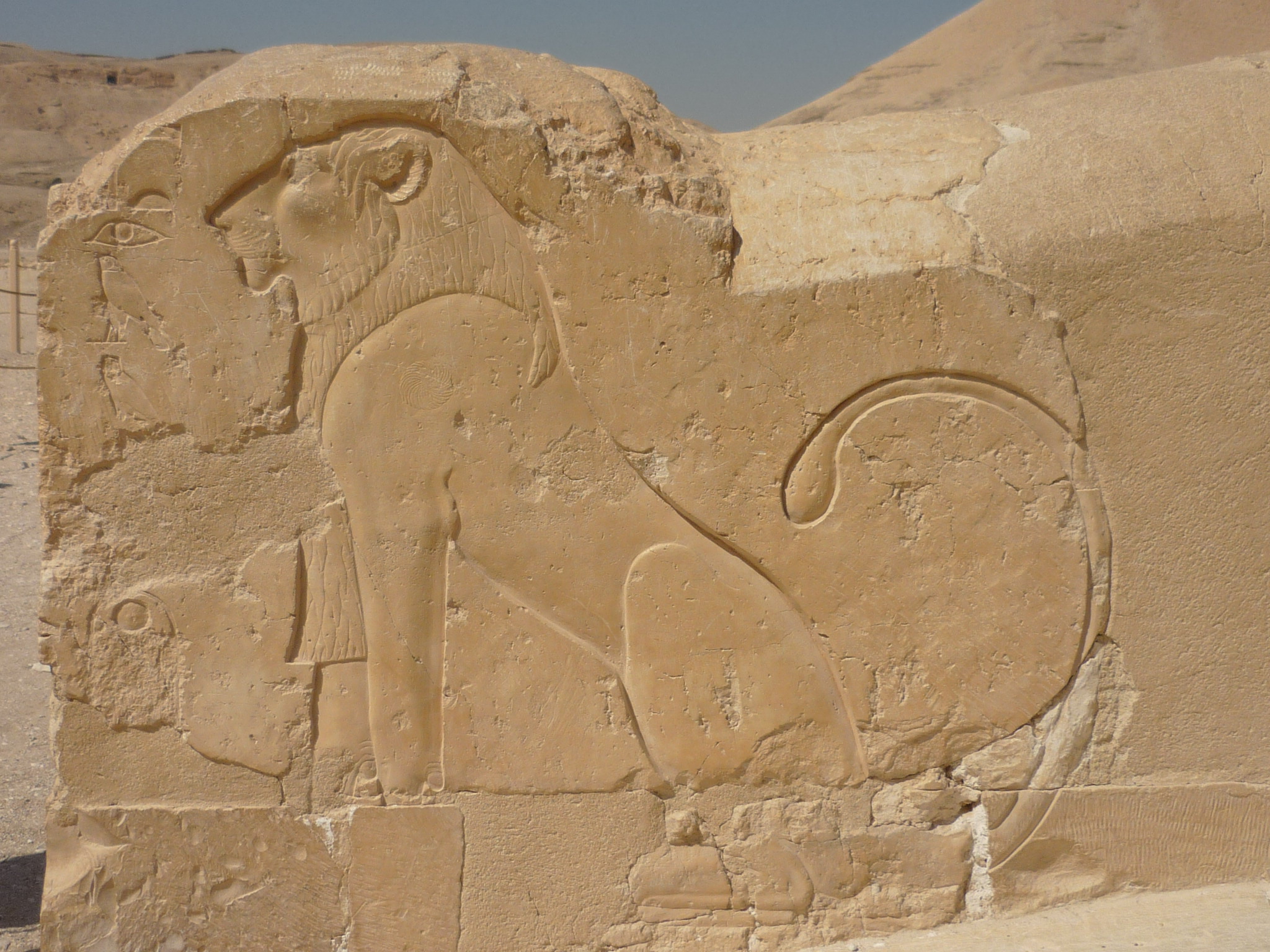We're now traveling along our earthly orbit around our central star to the point where a month has elapsed since the point of the June solstice, such that we are entering the period of the year designated as the sign of Leo the Lion.
For those who wonder if the motion of precession, which inexorably "delays" the background of stars as the successive ages roll past, means that this period no longer corresponds to the characteristics anciently associated with the month governed by the sign of the Lion, the answer is "no" according to the analysis presented by Thomas Burgoyne (1855 - 1894) in the first chapter of the second volume of his two-volume Light of Egypt (1889), which argues that it is not the actual background stars which create the conditions and influences which correspond to any particular portion of the year but rather the angle of the sun's light which is a product of the relationship between the earth (and earth's axial tilt) and the sun at any given time of the year.
He explains that "the sunrise on the first of March is wholly different from the sunrise on the first of May" and that "it is the angle at which we, the inhabitants, receive the Sun's light that makes all the difference," and that just as this angle of incoming sunlight changes throughout each day as our globe rotates (changing the angle at which we receive the solar rays from sunrise to noon to sunset), so also it is the changing angle of incoming solar radiation throughout the year which creates the different characteristics of each zodiacal "sign," and not the particular background constellation which might be present from one age to the next.*
Thus, even though precession has delayed the background of stars since the Age of Aries (when Leo was the constellation in which the sun was located during this part of the year), it is still appropriate to refer to the period beginning around July 22 or 23 and lasting until about August 22 or 23 as the period corresponding to the sign of Leo, and to understand that the characteristics particular to this part of our annual journey have not changed.
In his lectures on the celestial foundations of the ancient scriptures collected into what has come to be known as the Bible, the Reverend Robert Taylor of England (1784 - 1844) demonstrates that many of the descriptions of deity correspond to the Sun's movement through the different constellations of the zodiac band.
For example, in a lecture on the identity of the Apostle Peter delivered on February 20, 1831, he argues that the verse which declares that "the foxes have holes, and the birds of the air have nests, but the Son of man hath not where to lay his head" (found in Matthew 8: 20 and Luke 9:58) indicates that while the twelve Apostles all have houses, the Christ moves through each house without ever making one of them his permanent home (see Devil's Pulpit, page 148).
Elsewhere, Taylor argues that different aspects ascribed to deity contain explicit references to the characteristics of the different signs of the zodiac, including the "everlasting arms" of the sign of Cancer the Crab (the sign which commences with the highest point of the year, at the summer solstice), which Taylor discusses in a sermon found in Astronomico-theological Lectures, pages 262 - 263, or the vision of the Four Creatures in the Prophecy of Ezekiel, which Taylor mentions in the same sermon, on pages 263 through 268 and which I examine in great detail in previous posts such as this one, this one and this one, as well as in my 2016 book Star Myths of the World, Volume Three (Star Myths of the Bible).
Intriguingly, Taylor argues that the motion of the Sun through the sign of Leo the Lion, corresponding to the hottest time of the year and the time in which the Sun's path through the sky can still be said to be the highest path that it takes throughout the year helps us to understand aspects of the Most High, and that the very word "Lion" itself comes from ancient roots which evoke this concept.
Taylor argues on page 261 that the word ON itself is an ancient name of the Sun. Note that the ancient Egyptian city of Heliopolis (the City of the Sun) was known as ON to the ancient Egyptians themselves (a word which also may have been pronounced AWAN). Taylor argues that this word may be the origin of our word "One" (also found in his discussion on page 261), as well as the word Aion or Eon, signifying a tremendously long Age, or by extension the concept of Eternity and the Eternal.
To this word was added another word for deity, El (and note that the name of another ancient solar god, Helios, is closely related to this same sound -- and may well be the origin of our common greeting "Hello"). Combining the divine names EL and ON or EON would give the origin of the ancient word for Lion (which in Greek is a very similar word, sounding like "leon," which comes down into modern English with very little change).
Taylor asserts:
To the Amonian title ON, or EON, was frequently added the universal name of God, El, and the compound word EL-EON signifying God Eternal, or the Eternal God; and also the name of the noblest of animals, the LION. The Lion was transferred to the highest domicile of the Zodiac, and became the type of the Sun, being then most high: the Sun in July, as having attained his highest altitude and splendor. 262
One need not necessarily agree with every assertion or argument that Robert Taylor put forth in his lectures (and I myself do not agree with him on numerous points) to perceive the significance of his larger thesis, which is that the ancient scriptures of what we call the Bible are in fact elucidating eternal truths using celestial metaphor, and that they employ the majestic and everlasting cycles of the heavens to convey to our understanding powerful concepts regarding the Invisible Realm to which we actually have access at all times.
By ignoring the undeniable fact that the Bible is built on celestial metaphor (as are all the world's other ancient myths, scriptures and sacred stories), those who insist on interpreting them literally risk grievously distorting their message, and at the same time argue that the Biblical scriptures are somehow different from all the other sacred wisdom imparted in the form of myth to the cultures on every other part of our globe, on every inhabited continent and island.
In doing so, those insisting on literalizing the ancient scriptures also tend inevitably toward externalizing their message (because, almost by definition, if the ancient stories are describing literal, terrestrial history then they are describing things that pertain to other people, rather than dramatizing truths which pertain to each and every man and woman who has ever lived and to each and every man and woman alive today).
It is for this reason that Alvin Boyd Kuhn, in his 1940 masterpiece Lost Light, asserts that the ancient wisdom did not "leave out" or deny the existence of the Eternal, but that "it had the discretion to leave it alone!" He argues that the ancient teachers point us towards "contact with a god dwelling immediately within the human breast. No reaching after the moon of the Absolute diverted conscious purpose from actual touch with the god who stood at one's elbow" (45 - 46).
This focus, Kuhn argues, implies no disrespect for the Absolute -- but instead urges "recognition of deity at the point where it was most accessible. The real heresy and apostasy," he asserts, "is to miss deity where it is to be had in the blind effort to seek it where it is not available" (46).
With this perspective in mind, have a look at this article on "the Lion's Gaze" published by researcher and teacher Richard Cassaro, who has documented startling correspondences in architecture and symbology found in ancient monuments around the world -- correspondences which demolish the conventional historical paradigm which refuses to acknowledge the overwhelming evidence pointing to the existence of an ancient predecessor culture whose influence can be seen even in the earliest art and mythology of the most ancient civilizations known to us at this time.
In that 2015 article, Richard Cassaro points to an ancient parable, which is related in writings attributed to the 11th century Tibetan yogi Milarepa, which teaches that a dog chases a stick one throws, but a lion instead chases the thrower of the stick!
The meaning, as Richard elucidates in his exposition of the parable, is that like the lion we should not waste our effort chasing after that which is external (exemplified by the dog chasing after a stick) but rather that we should turn our attention to the heart of the issue -- which is to be found within ourselves and not in any external distraction.
In doing so, we ourselves can begin to manifest the characteristics associated with the Lion: majesty and dignity (attributes that cannot be approached by chasing after sticks, even if we dutifully retrieve thousands of sticks thrown for us).
This is a very powerful teaching indeed, and one which we can profitably practice at any season of the year -- but perhaps most especially during this season of the Lion.
---------------
* Note, of course, that just because I agree with Thomas Burgoyne's arguments on this particular point does not mean that I endorse everything else that he asserts in his encyclopedic Light of Egypt texts from 1889, or everything else that he ever wrote in other places.


















